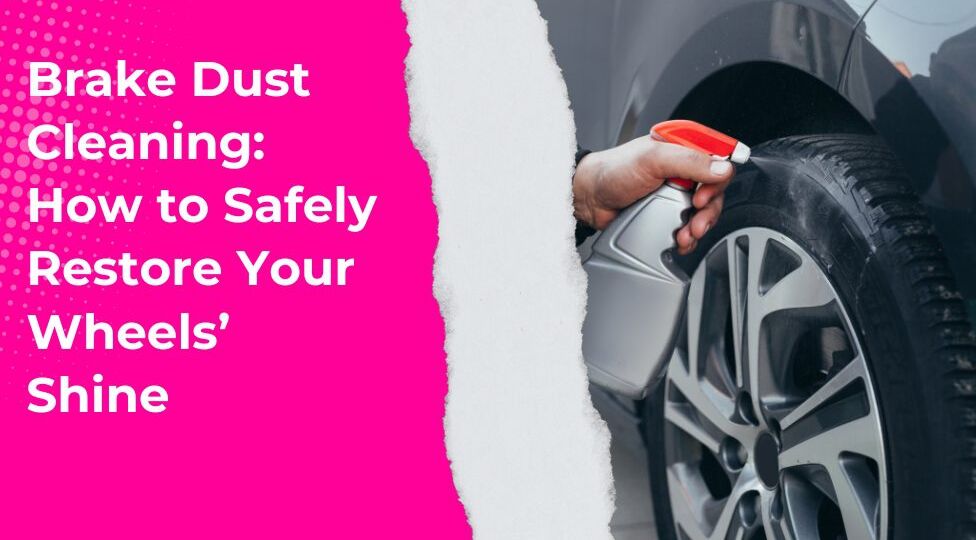
Introduction
Wheels aren’t just part of your car’s style—they play a key role in safety and performance. But they often suffer the most from grime and harsh conditions, especially from brake dust, which can be surprisingly damaging if left untreated. Regular cleaning is essential to keeping your wheels looking great and functioning properly. In this guide, we’ll walk you through how to remove brake dust safely and effectively without harming your wheels.
What Exactly Is Brake Dust?
Brake dust is a byproduct of friction between your brake pads and rotors. It’s made up of tiny metal particles, carbon fibers, and adhesives that are released every time you brake. These particles can bake onto the surface of your wheels due to heat, forming a corrosive layer that dulls the finish and may even damage the wheel over time.
Cleaning this dust away regularly helps protect your wheels, keeps your car looking fresh, and reduces the risk of long-term wear.
How Often Should You Clean Your Wheels?
To prevent brake dust from building up, it’s ideal to clean your wheels every one to two weeks. If you drive in heavy traffic, dusty environments, or near construction zones, you may need to clean them more frequently.
Tools You’ll Need for Safe Brake Dust Removal
Before you begin, assemble the following:
- A pH-neutral wheel cleaner
- Soft wheel brush and detailing brushes
- Microfiber cloths or a dedicated wheel mitt
- Pressure washer or hose with spray nozzle
- Optional: Wheel protectant or ceramic topper
Step-by-Step Process to Clean Brake Dust Safely
Step 1: Initial Rinse
Begin by thoroughly rinsing the wheels to loosen dirt and surface contaminants. A pressure washer works best, but a strong stream from a hose also helps knock away loose particles.
Step 2: Apply Wheel Cleaner
Choose a non-acidic, pH-balanced cleaner that’s compatible with your wheel finish. Spray generously on a cool and dry wheel, allowing the solution to sit for a few minutes. If your cleaner reacts with iron, you’ll often see a purple hue as it starts to dissolve the brake dust.
Step 3: Agitate Gently
Use a soft-bristled wheel brush to scrub the surface, paying attention to lug nut areas, spoke backs, and barrel interiors. Reach tight corners using smaller detailing brushes to get a complete clean without scratching.
Step 4: Rinse Thoroughly
After scrubbing, rinse away all remaining cleaner. Don’t leave any residue behind—leftover chemicals can dry on the surface and cause damage or streaking.
Step 5: Dry and Inspect
Use a clean microfiber towel to dry each wheel. Not only does this prevent water spots, but it also gives you a chance to check your work and repeat cleaning if any stubborn areas remain.
Smart Tips for Effective Wheel Cleaning
- Work on one wheel at a time to prevent cleaner from drying before you rinse.
- Avoid cleaning when wheels are hot—this can reduce the effectiveness of the product.
- Never use kitchen or household cleaners on your wheels—they’re too harsh.
- Always use separate tools and towels for wheels and paint to avoid cross-contamination.
- After cleaning, apply a wheel sealant or ceramic boost to repel future dirt and brake dust.
Choosing the Right Brake Dust Cleaner
The best wheel cleaners are:
- pH-neutral to avoid damaging finishes
- Iron-reactive to target embedded brake dust
- Non-corrosive, safe for all wheel types (alloy, painted, polished, etc.)
Reading labels and choosing the right cleaner ensures effective cleaning without the risk of damaging delicate surfaces.
Why Routine Wheel Care Matters
Consistent wheel maintenance isn’t just cosmetic. It:
- Helps prevent etching and corrosion caused by brake dust buildup
- Supports optimal performance by keeping braking surfaces clean
- Protects your investment by maintaining your car’s appearance
- Reduces wear and tear, especially on wheels with sensitive finishes
Common Mistakes to Avoid
Even seasoned drivers sometimes overlook these:
- Neglecting regular cleaning allows brake dust to harden and become more difficult to remove.
- Using abrasive brushes can leave scratches or strip coatings.
- Skipping the rinse step can leave chemical residue that damages your wheels.
- Spraying tire shine on wet tires can cause slinging, undoing your hard work.
Conclusion
Brake dust might seem harmless, but it’s one of the most aggressive contaminants your wheels face. With the right tools, products, and technique, you can easily clean your wheels without damaging them—maintaining both their beauty and function.
Add wheel care to your regular detailing routine, and your vehicle will reward you with improved aesthetics, safer braking, and a polished, well-kept look on every drive.

